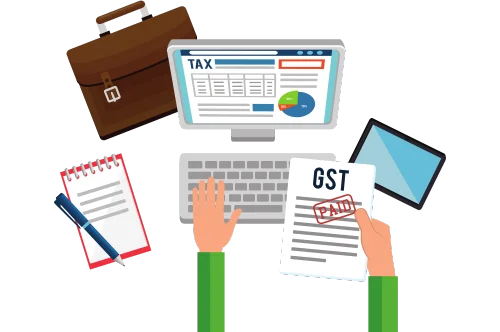We Are Taxed Like the USA and Service Provided Like Somalia
India’s tax system is often seen as a heavy burden on its citizens. With a range of indirect taxes, direct taxes, and other levies, the country’s taxation system has increasingly been compared to that of developed nations, while the public services provided in return are often criticized for being inadequate. The paradox becomes stark when you realize that India’s tax rates and collection system are comparable to the likes of the USA, but the services that its citizens receive resemble those of countries with much lower tax-to-GDP ratios. This article will explore how India is taxed like the USA, yet provides services akin to developing nations with a focus on healthcare, education, infrastructure, and overall social services.
1. High Indirect Taxes: The Burden of GST and Excise Duties
One of the primary components of India’s tax system is the Goods and Services Tax (GST), a consumption-based tax that has a significant impact on the cost of goods and services in the country. India imposes a multi-slab GST structure with rates ranging from 5% to 28%. The highest rate of 28% is applied to luxury and sin goods, including items like high-end cars, aerated drinks, and tobacco products.
India’s tax system’s reliance on high GST rates is evident in the price of everyday items. For example, essential goods may have a GST of 5%, but luxury goods face the highest rate of 28%. To put this in perspective, countries like the United States have a sales tax rate of around 7-10%, significantly lower than India’s GST rate for high-end products. Similarly, European Union countries apply a standard VAT rate of around 20%, with higher rates for some goods, but India’s luxury goods tax is considerably higher.
Fuel taxes, which make up a significant portion of India’s excise duties, add another layer of complexity to India’s tax system. Fuel taxes constitute about 50-60% of the retail price of petrol and diesel. The global average fuel tax rate is considerably lower, with countries like Saudi Arabia, Venezuela, and the USA having fuel prices significantly lower than in India, primarily due to subsidies or lower tax rates.
Concrete Example:
In India, the price of petrol in Delhi can exceed ₹100 per liter, and more than half of this price consists of taxes. On the other hand, in countries like the USA, fuel taxes are relatively lower, leading to a more affordable price at the pump. This shows that India’s tax system is highly reliant on indirect taxes, which disproportionately affect lower-income groups, making it feel like India is taxed like developed nations such as the USA, but with fewer corresponding benefits.
2. Income Tax Structure: Middle-Class Tax Burden
India’s tax system also heavily taxes the middle-class population through its income tax structure. Though the income tax rates themselves range from 5% to 30%, the cess and surcharge system raises the overall tax burden. For instance, individuals earning more than a specific threshold also need to pay a 4% health and education cess, which further increases the effective tax rate.
In India’s tax system, the surcharge is applied on high-income earners, which means that the wealthiest individuals, earning above ₹1 crore annually, pay as much as 30% on their income, plus the health and education cess. This is not dissimilar to the USA’s tax system, where the top tax bracket is around 37%. However, the effective tax rate in the USA can be lower for middle-class citizens due to deductions, exemptions, and other tax benefits that are not available to a large portion of India’s tax system‘s population.
While income taxes in India’s tax system are high, a significant portion of the population doesn’t pay income taxes at all, creating an imbalance where the tax burden is disproportionately borne by the salaried class. This makes it feel like India’s tax system is designed to extract maximum tax from the middle class, similar to the USA‘s system, but with fewer social welfare benefits.
3. Corporate and Dividend Taxes: Impact on Investment Returns
The corporate tax rate in India is competitive, ranging from 15% to 25%, which is somewhat similar to the tax rates in OECD countries. However, India’s tax system imposes dividend distribution taxes and capital gains taxes, which can dampen investment returns.
Dividend Taxation: India’s dividend distribution tax is around 10%, which can seem high compared to the USA, where dividend taxes are relatively lower. The effect of this tax is compounded by the fact that India lacks a well-developed tax-saving infrastructure for investors, unlike in the USA, where mechanisms like tax-free bonds or retirement accounts allow individuals to reduce their tax burdens.
Additionally, the capital gains tax on the sale of investments in India can be as high as 15-20%, depending on the duration of the investment. In comparison, countries like the USA offer preferential tax treatment for long-term capital gains, which can be taxed at a lower rate.
Concrete Example:
A citizen investing in the stock market or mutual funds in India would not only face taxes on the income from those investments but also be taxed on the capital gains. This results in lower overall returns, especially when compared to countries with tax-advantageous investment schemes like the USA, where investment returns are treated more favorably under the tax code.
4. Regressive Taxes on Fuel and Sin Goods
India’s tax system also heavily depends on regressive taxes, especially on fuel and sin goods such as alcohol, tobacco, and gambling. These taxes disproportionately affect lower-income citizens, who spend a larger portion of their income on basic goods and services, including fuel.
The government relies on these taxes to generate revenue for the state, despite the fact that they hit the poorer sections of society the hardest. In countries like the USA and Saudi Arabia, fuel taxes are lower, making essential goods more affordable. While these taxes are a major source of revenue for India’s tax system, they contribute to a disproportionate tax burden on low-income earners, as they consume a higher proportion of their income on basic goods.
5. The Service Deficit: Low Public Services for High Taxes
Despite the heavy tax burden placed on Indian citizens, the public services offered by the government are often subpar. One of the most striking aspects of India’s tax system is the mismatch between the taxes collected and the quality of services delivered, particularly in the areas of healthcare, education, and infrastructure.
In countries with high tax-to-GDP ratios, like Denmark (where the ratio is around 41.4%), citizens enjoy access to free healthcare, universal education, and well-maintained public infrastructure. In contrast, India’s tax system collects taxes from its citizens, but the quality of public services often fails to meet expectations.
Healthcare: India spends just 1.3% of its GDP on healthcare, one of the lowest among major economies. In comparison, countries like Norway spend upwards of 10% of their GDP on healthcare, offering free or heavily subsidized healthcare to their citizens.
Education: Public education in India suffers from overcrowded classrooms, outdated facilities, and underfunded institutions. Despite paying taxes, many citizens opt for private schooling, which comes at a significant cost.
Concrete Example:
Consider India’s healthcare system. A citizen in India may pay high taxes but receive inadequate healthcare services. A visit to a government hospital often results in long wait times, lack of basic medical supplies, and overcrowded facilities, making citizens feel like they are taxed heavily, yet have access to poor public services. In contrast, countries with higher tax-to-GDP ratios like France offer universally accessible, high-quality healthcare.
6. Conclusion: India’s Tax System – A Heavy Burden for Inadequate Services
In conclusion, India’s tax system imposes a heavy burden on its citizens, similar to the USA, with high indirect taxes, income tax rates, and corporate taxes. However, the public services provided by the government often fail to meet the expectations of the taxpayers, resembling those in underdeveloped countries. The mismatch between the taxes collected and the quality of services delivered is a critical issue for Indian citizens, who are often left feeling as though they are taxed like the USA, but the services provided are closer to what you would expect in a country like Somalia.
As India continues to push for economic growth and tax reforms, the key challenge will be ensuring that the taxes paid by its citizens are reinvested into improving public services. Without adequate infrastructure, healthcare, and education, the tax burden will continue to feel unjust, leaving citizens frustrated by the lack of tangible benefits from their contributions.
References:
- OECD Revenue Statistics 2024
- World Bank – Healthcare and Education Expenditure Reports
- India’s Union Budget 2023 – Tax and Cessation Details
- GST Council of India
- IMF World Economic Outlook
Our GST Services

All E-commerce Tax services
E-commerce tax services help online sellers navigate GST registration, compliance, return filing, TCS management, tax planning, and audits, ensuring efficient tax management and legal compliance.

GST Filing
GST filing is the process of submitting tax returns to the government, detailing sales, purchases, and taxes paid or collected, ensuring compliance with GST laws.

GST Registration
GST registration is the process where businesses obtain a GSTIN from the government, allowing them to collect taxes, claim input tax credits, and comply with GST laws.





